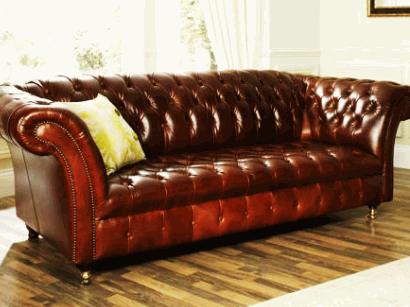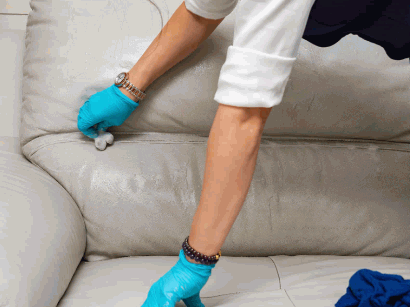Leather sofas are a stylish and luxurious addition to any living space, but they require proper care to maintain their beauty and longevity.
We explore the importance of taking care of a leather sofa and the factors that can damage it. We will also discuss the best cleaning products and techniques to use, as well as how to protect the sofa from stains.
Find tips on how to maintain the appearance of a leather sofa and common mistakes to avoid. Learn how to keep your leather sofa looking its best!

Contents
Taking care of a leather settee is essential to ensure its longevity and maintain its appearance. Leather settees are often significant investments in furniture, and proper care can help preserve their value over time. Consulting a leather specialist can provide expert advice on the best practices for maintaining your leather settee.
Leather furniture, including settees, requires attention and specific care routines to safeguard against premature wear and tear. Regular conditioning and cleaning are essential to prevent cracks and fading, ensuring that your leather settee remains supple and elegant. By following the guidance of a leather care specialist, you can prolong the lifespan of your settee and retain its aesthetic appeal for years to come. Upholstery experts can recommend suitable products and techniques tailored to your specific leather type, guaranteeing optimal maintenance and protection.

Several factors can contribute to damaging a leather sofa, including improper cleaning methods that may strip the leather of its natural oils. Exposure to water or direct sunlight can also lead to discolouration and deterioration of the leather over time.
Regarding cleaning leather sofas, using harsh chemicals or abrasive cleaners can harm the material, making it more prone to cracking and drying out. Opt for gentle leather cleaners specifically formulated for this type of furniture to maintain its softness and durability. Excessive exposure to water can cause the leather to swell and warp, disrupting its natural texture and shape. Sunlight, while giving a natural warmth, can fade the colour of the leather over time, resulting in a dull appearance.
Cleaning a leather sofa requires gentle yet effective methods to remove dirt and stains without damaging the leather surface. Using a suitable leather cleaner and a soft cloth, you can maintain the cleanliness of your sofa while preserving its quality.
When cleaning your leather sofa, make sure to choose a cleaner specifically designed for leather to avoid any potential harm. Avoid using harsh chemicals or abrasive materials that can cause irreparable damage to the leather. It's advisable to test any cleaner on a small, inconspicuous area first to ensure compatibility with your sofa.
Always remember to use a soft, lint-free cloth to gently clean the surface in a circular motion, avoiding excessive pressure to prevent scratching or scuffing the leather.

When cleaning a leather sofa, it is crucial to use specific products designed for leather care, such as leather conditioners or white vinegar solutions for gentle yet effective cleaning. These products help nourish the leather while maintaining its natural texture and appearance.
Leather conditioners work by moisturising the leather, preventing it from drying out and cracking over time. They also provide a protective layer that shields the leather from stains and spills.
On the other hand, white vinegar solutions are excellent for removing stubborn stains and odours from leather sofas. The mild acidity of vinegar effectively breaks down dirt and grime without causing any damage to the leather.
It is advisable to test any new cleaning product on a small, inconspicuous area of the sofa before applying it to the entire surface to ensure compatibility.
Avoid using strong household products or excess water when cleaning a leather settee, as these can harm the leather finish and lead to unwanted marks or discolouration. Choose gentle methods and avoid direct use of purified water on the leather surface.
Instead of using potent chemicals or harsh cleaners, choose specially formulated leather cleaners designed to delicately remove dirt and grime without causing damage. These products are pH-balanced to safeguard the natural oils in the leather and preserve its softness and durability.
Avoid saturating the leather in water or using excessive moisture during cleaning, as this can result in watermarks and may cause the leather to parch and crack over time. Instead, lightly moisten a microfibre cloth with a small amount of mild soap and water to gently clean the surface, followed by immediate drying with a clean, dry cloth.
Protecting a leather sofa involves preventing stains and maintaining its suppleness with the use of quality leather conditioners. Regular conditioning can help create a protective layer that safeguards the leather from potential damage.
Regarding stain prevention, one effective method is to promptly blot any spills with a clean, dry cloth to prevent them from seeping into the leather. Avoid using harsh chemicals or cleaners as they can strip the natural oils from the leather, leading to dryness and cracks. Placing your leather sofa away from direct sunlight and heat sources can help prolong its lifespan by preventing fading and premature aging.

Preventing stains on a leather settee involves proactive measures such as avoiding food and liquid spills, regular cleaning, and immediate treatment of any accidental stains. Following a consistent leather care routine can significantly reduce the risk of stubborn stains.
Regarding keeping your leather settee looking its best, prevention is key. One effective method is to utilise protective sprays or conditioners specifically designed for leather to create a barrier against spills and stains. Placing coasters or trays on the settee to prevent direct contact with glasses or dishes can help prevent accidents. It's also important to promptly blot any spills with a clean cloth to absorb as much liquid as possible before it penetrates the leather.
Choosing the right leather conditioner is crucial for maintaining the quality and appearance of a leather sofa. Leather specialists often recommend specific conditioners that are suitable for different types of leather, ensuring optimal care and protection for your sofa.
Regarding leather care, using the wrong conditioner can do more harm than good, potentially causing discolouration or damaging the material. Leather specialists can offer valuable insights into the best products to use based on the type and condition of your leather sofa.
Consulting with experts in the field can help you avoid common mistakes and ensure that your sofa receives the proper treatment it deserves. Selecting a high-quality conditioner can prolong the lifespan of your leather furniture and maintain its luxurious feel.
Gain insights: What Is The Best Leather Conditioner For Couches
Dealing with spills or stains on a leather settee requires prompt action to prevent permanent damage. Following specific cleaning steps tailored to the type of stain can help effectively remove the blemish without harming the leather surface.
When a spill occurs on your leather settee, the first step is to act quickly. Blotting the spill with a clean cloth can help prevent it from seeping into the leather. Avoid rubbing the stain as it may spread and penetrate further into the material.
For different types of stains, such as ink, grease, or food, using appropriate cleaning agents is crucial. Test any cleaner on a hidden area of the settee first to ensure it doesn't cause discoloration or damage.

Different types of stains on a leather settee require specific removal techniques. Using a suitable leather cleaner and following proper stain removal methods can help effectively eliminate stains without causing further damage to the leather.
For water-based stains, gently blot the affected area with a clean cloth to soak up excess liquid. Avoid rubbing, as it can spread the stain. Mix a small amount of mild soap with water to create a gentle cleaning solution and dab it onto the stain. For oil-based stains, sprinkle bicarbonate of soda or cornflour onto the affected area and let it sit for a few hours to absorb the oil. Vacuum the powder and then treat it with a leather cleaner to remove any residue.
Maintaining the appearance of a leather settee requires regular care and attention to prevent wear and tear. Establishing a maintenance routine that includes cleaning, conditioning, and protective measures can help preserve the pristine look of your settee.
Regular cleaning is essential to remove dirt and dust that can accumulate on the surface of the leather. Using a soft, damp cloth or a vacuum cleaner with a brush attachment can effectively clean the settee without damaging the material.
Conditioning the leather with a specialised leather conditioner helps to hydrate the material and prevent it from drying out and cracking over time. Implementing protective measures such as using leather protectant sprays can safeguard the settee from spills and stains, prolonging its lifespan.

Implementing best practices for regular maintenance of a leather sofa involves dusting, cleaning, conditioning, and protective measures on a consistent basis.
Regular dusting using a soft cloth or vacuum cleaner with a brush attachment helps remove dirt and debris that can accumulate on the surface of the leather.
Cleaning should be done with a mild soap or leather cleaner, followed by thorough drying to prevent water damage.
Conditioning the leather using a specialised leather conditioner keeps it moisturized and prevents cracking or drying out over time. It's recommended to apply conditioner every 6-12 months, depending on usage.
Protective measures such as avoiding direct sunlight and sharp objects, using a leather protector spray, and rotating cushions regularly can help maintain the appearance and quality of your sofa.
Determining the frequency of cleaning and conditioning for a leather sofa depends on factors such as usage, environmental conditions, and the type of leather. Consulting a leather specialist can help establish a tailored care schedule for optimal maintenance.
Regular cleaning and conditioning are essential to maintain the beauty and longevity of leather settees. For lightly used settees in a clean indoor environment, a thorough cleaning every 6-12 months may be sufficient. High-traffic areas or homes with pets and children may require more frequent care, possibly every 3-6 months.
Environmental factors, such as humidity and sunlight exposure, can also impact leather. UV rays can cause fading and drying out, so placing the settee away from direct sunlight and using a protective coating can help prevent damage.
Avoiding common mistakes in leather sofa care is crucial to prevent damage and maintain the quality of the leather. Using improper cleaning products or techniques can result in stains, discoloration, or deterioration of the sofa over time.
One common mistake individuals make is using harsh chemicals on their leather sofas in an attempt to remove stains quickly. These chemicals can strip away the natural oils in the leather, leading to dryness and cracking.
Another error to watch out for is using abrasive tools like rough brushes or scrubbing pads. These can scratch the surface of the leather, causing permanent damage that is difficult to repair.
Neglecting to condition your leather sofa regularly can result in the leather becoming dry and prone to cracking. Proper conditioning helps to maintain the suppleness and luster of the leather over time.
In conclusion, caring for a leather sofa requires attention to detail, regular maintenance, and the use of appropriate products and techniques.
Consulting a leather specialist can provide valuable insights and guidance on preserving the beauty and longevity of your leather sofa.
Proper maintenance not only enhances the aesthetic appeal of your furniture but also extends its lifespan, ensuring a wise investment in the long run.